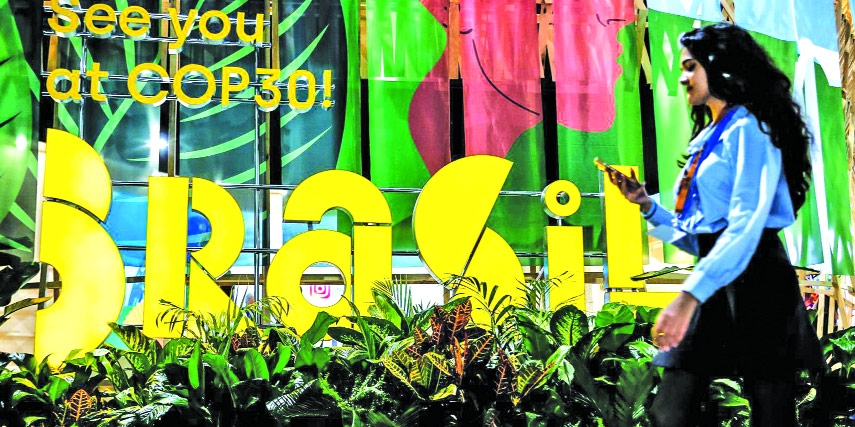Published: 08:53 AM, 18 November 2025
COP30 and the Forgotten Frontline: Why Bangladesh Must Treat Climate Change Crisis as a National Security Priority

When the world’s leaders, scientists, and climate negotiators gather in Belém, Brazil, this November (from 10 to 21 November 2025) for COP30, the agenda will once again center on the planet’s most existential threat—climate change. COP30 refers to the 30th meeting of the Conference of the Parties (COP) under the UN Framework Convention on Climate Change (UNFCCC), a landmark international treaty adopted in 1992 and the foundational framework for the 2015 Paris Agreement.
The UN Climate Change Conference, or the Conference of the Parties (COP), is the only multilateral decision-making forum where nearly every nation on Earth deliberates on how to limit global temperature rise to 1.5°C, adapt to irreversible climate impacts, and achieve net-zero emissions by 2050. But as global leaders debate pledges and frameworks, Bangladesh stands as a case study of both human resilience and governmental apathy—a nation at the epicenter of the climate crisis, yet paralyzed by inaction. Once hailed as a model for adaptation, Bangladesh now risks becoming a tragic symbol of neglect, as its policymakers continue to treat climate change as an environmental issue, not a national security or survival crisis.
Bangladesh’s geography is its greatest curse. Crisscrossed by more than 700 rivers, the country lies at the mouth of the mighty Ganges-Brahmaputra-Meghna delta—one of the world’s largest river systems and, tragically, one of its most climate-vulnerable zones. The Intergovernmental Panel on Climate Change (IPCC) repeatedly warns that a 1-meter rise in sea level could submerge 17% of Bangladesh’s land, displacing nearly 30 million people. The World Bank projects that by 2050, climate change could internally displace 13 million Bangladeshis, creating one of the largest populations of “climate refugees” in modern history.
This is not theoretical. In Satkhira, Khulna, and Bhola, saltwater intrusion has already poisoned groundwater and farmland, forcing thousands to abandon ancestral homes. Coastal women are suffering from fertility issues due to saline-contaminated drinking water. In the country’s north, severe droughts are destroying paddy yields. In the east, flash floods are now frequent and unpredictable. Bangladesh’s climate crisis is not a future forecast—it is a lived reality. And yet, policy attention remains startlingly minimal.
The United Nations Development Program (UNDP) and the UN Environment Program (UNEP) have issued repeated warnings: Bangladesh is among the top 10 most climate-vulnerable countries globally. According to the Global Climate Risk Index, it ranks seventh in long-term vulnerability.
The UN Office for Disaster Risk Reduction (UNDRR) cautioned that Bangladesh’s “adaptation achievements” are being outpaced by the scale of new threats—notably extreme heat, tidal surges, riverbank erosion, and slow-onset disasters such as salinization and desertification. In 2024, the World Bank reported that heat-related productivity losses cost Bangladesh $1.8 billion—about 0.4% of GDP—in just one year. The UNEP Emissions Gap Report (2024) further warned that unless Bangladesh integrates mitigation with adaptation, its economic growth could shrink by up to 30% by 2050 due to climate-induced disruptions. The international alarm is clear. What’s unclear—and unforgivable—is why Dhaka remains so complacent.
Bangladesh’s ruling elites treat climate change as a side note, a “development” topic rather than a survival imperative or a national agenda. The country has produced strategies—Bangladesh Climate Change Strategy and Action Plan (BCCSAP), Delta Plan 2100, and a National Adaptation Plan—but most exist on paper. There is no comprehensive implementation architecture, no independent oversight, and no climate accountability mechanism integrated into governance or fiscal policy.
Three structural failures stand out:
Bureaucratic Fragmentation: Climate action is scattered across ministries—the Ministry of Environment drafts plans, but Finance controls budgets, and Local Government implements projects. The result? Disjointed action and duplication.
Chronic Underfunding: Bangladesh spends less than 1% of GDP annually on climate adaptation, far below the estimated 3% needed. While the government often blames “insufficient international finance,” it continues to pour billions into carbon-intensive infrastructure projects, including coal and LNG-based power plants.
Policy Distraction and Political Denial: For over a decade, political discourse has been consumed by power struggles and regime survival, not planetary survival. Climate change rarely features in national electoral debates or parliamentary agendas. The silence is deafening.
The government’s “growth-first” obsession has created a paradox: economic progress built on ecological and climate collapse. As rivers vanish, coastlines retreat, and cities choke, the national narrative still celebrates GDP growth—an illusion increasingly detached from environmental reality. A decade ago, Bangladesh was celebrated globally as a climate adaptation pioneer. Community-based cyclone shelters, early warning systems, and microfinance for disaster recovery were hailed as models for vulnerable nations.
Today, that reputation has faded. The Bangladesh Climate Change Trust Fund (BCCTF)—once praised for its innovation—has been tainted by mismanagement and lack of transparency. Funds are routinely allocated to politically connected projects with little measurable impact. The Bangladesh Delta Plan 2100, theoretically a long-term vision to safeguard the delta from rising seas, has become a bureaucratic labyrinth with weak implementation and questionable sustainability.
Meanwhile, grassroots adaptation initiatives—run by NGOs and local communities—remain underfunded and isolated from national planning. Policymakers in Dhaka have failed to connect top-down strategy with bottom-up resilience. The result: Bangladesh is losing the race between adaptation and acceleration. The climate threats are evolving faster than the country’s institutional response.
At present, in Bangladesh, climate change crisis is not just an environmental issue, it becomes a national security crisis. Here lies the fundamental misunderstanding: climate change in Bangladesh is not about “saving the environment.” It is about saving the state. Unchecked, climate collapse will destabilize every pillar of national life:
Economy: Shrinking arable land will cripple agriculture, still employing 40% of the workforce.
Migration: Internal displacement will flood urban centers like Dhaka, aggravating unemployment, housing crises, and social unrest.
Health: Heatwaves, vector-borne diseases, and contaminated water will trigger new public health emergencies.
Health: Heatwaves, vector-borne diseases, and contaminated water will trigger new public health emergencies.
Security: Resource scarcity—water, land, and food—will heighten local conflicts, threatening internal stability.
Even the Bangladesh Armed Forces, long focused on disaster relief, now recognize climate as a “threat multiplier.” But civilian leadership has yet to translate that understanding into comprehensive strategy.
As the world meets in Belém, Bangladesh must confront a simple truth: it cannot survive on sympathy—it needs strategy. To avoid becoming a climate tragedy, the country must urgently recalibrate along three fronts.
Treat Climate as the Core of Economic Planning: Climate policy cannot remain siloed within the Environment Ministry—it must be embedded into every budget and decision. Bangladesh needs a National Climate Accountability Act, mandating that every public investment pass a “climate resilience audit.” Additionally, the Finance Ministry must reallocate subsidies from fossil fuels to renewable energy, green infrastructure, and resilient agriculture. A Bangladesh Climate Resilience Fund, jointly managed with UNDP and civil society, could ensure transparency and results-based financing.
Lead, Not Lament, in Global Negotiations: Bangladesh should arrive at COP30 not as a helpless victim, but as a moral and strategic leader among climate-vulnerable nations. Dhaka must demand: Concrete mechanisms under the Loss and Damage Fund for automatic compensation when climate thresholds are breached. Technology transfers for renewable energy and water management. Direct financing for locally-led adaptation, bypassing slow multilateral bureaucracy.
Mobilize Society, Not Just Government: Real resilience will not come from ministries—it will come from the grassroots. Bangladesh must mobilize youth, private sector innovators, and local communities into a national climate corps focused on reforestation, coastal restoration, and clean energy innovation.
Environmental education must become mandatory across all schools, colleges and universities to build generational awareness. Media, too, has a vital role—to transform climate coverage from seasonal disaster reporting to sustained policy scrutiny.
Bangladesh’s tragedy is not its geography—but its governance. The land may be doomed to floods and cyclones, but the real flood is of indifference, the real storm is of negligence. As the UN rings alarm after alarm, Dhaka’s silence borders on moral failure. The nation that once inspired the world with its resilience now risks becoming the epicenter of catastrophe for showing indifferences in climate change crisis.
The climate crisis is rewriting Bangladesh’s history in real time—its rivers drying, its coasts retreating, its people displaced. The question is not whether the world will act, but whether Bangladesh will act for itself. Without domestic political will and international accountability, Bangladesh risks becoming a permanent state of suffering—where the global South experiments in survival while the global North debates emissions arithmetic. At COP30, the world will talk of promises. Bangladesh must talk of survival. Because for this nation of rivers and resilience, inaction is not apathy—it is suicide.
Emran Emon is a journalist,
columnist and a global
affairs analyst.
Emran Emon is a journalist,
columnist and a global
affairs analyst.



